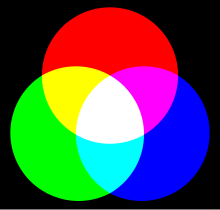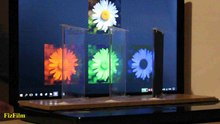Additive color mixing
The additive color mixing (also additive color synthesis or physiological color mixing is) a phenomenon that the change of the eye perceived color impression by successive addition of a respective other color stimulus describes (additive = adding). Basically, color vision is an additive mixture with the help of differently color-sensitive sensors in the eye. Since the additive color mixing takes place in the eye and brain, it is also called physiological color mixing.
The additive mixture in the trichromats , to which humans belong, is described by the three-color theory of Thomas Young and Hermann von Helmholtz . If the three primary colors red , green and blue are added in a suitable brightness , the color perception is white . The sensation is black when the sum is zero (no light). The sums of two primary colors produce the sensations yellow , cyan and magenta (secondary colors).
The creation of color stimuli that are spatially or temporally close to one another is also called additive color mixing , although the effective mixing process only takes place in the eye and brain.
- "Tight" bundles of differently colored light sources (for example on screens and monitors ) or splashes of color (as in pictures using the painting technique of pointillism ) create an overall impression; such a “tight” bundle is perceived as a unit and not as several light sources or several swabs.
- A rapid change of colored surfaces over time, as is achieved with the color spinning top , results in a uniform impression of the surface.
- The simultaneous illumination of a diffusely scattering screen with differently colored light sources corresponds to the borderline case of narrow bundles of differently colored points, because each point on the surface (diffuse) reflects the light from all sources.
If the intensity of partial spectral areas from the light from the light sources is reduced, one speaks of subtractive color mixing (subtractive = taking away). The subtractive color mixing is also called physical color mixing because, in contrast to the additive color mixing, it is purely objective and does not take place afterwards in the eye and brain.
functionality
The ideal of additive color mixing can be represented by a situation in which three spotlights of the same color intensity with the light colors red, green and blue illuminate a white surface, whereby the three color circles partially overlap. Each of the three projection circles appears in its pure color as long as it hits the projection surface alone. If two circles of light intersect, secondary colors are created, the colors yellow, magenta and cyan. All three circles of light intersect in the middle - the mixture appears white. The color black is represented by the darkness in the surrounding space. By regulating the intensity of the light emitters, any color nuance can be set in the overlapping area of all three basic colors. Colored shadows are created at overlapping areas .

| red | + | green | = | yellow | ||
| green | + | blue | = | Cyan | ||
| red | + | blue | = | magenta | ||
| red | + | green | + | blue | = | White |
Areas of application
Additive color mixing is the basis for those color rendering processes that are based on the RGB color space . Applications exist in particular in screens , such as color television . Digital photography is also based on this form. Depending on the color rendering process, different grids are used, such as the grain grid , the line grid or the lens grid method . The technical problems of color rendering are based primarily on the availability of economically, technologically and technically suitable phosphors with corresponding luminescence in the required excitation range. The description of colored areas on websites can be converted into web colors by specifying the proportions of the primary colors accordingly.
In technical systems, the additive color rendering is described using different three-dimensional color models . The aim is to adapt these to the "natural color of the user", the natural LMS space , as far as possible. The (technically) representable color space can be improved by additional lights (i.e. four-dimensionality). Sharp first chose this option in 2010 for its LCD televisions . With a fourth luminescent material in addition to the previous RGB pixels, red, green, blue luminous dots, yellow subpixels (RGBY) are installed for color mixing. These (extended) luminous dots are controlled by mathematical conversions. The technical goal is the improved reproduction of the critical yellow, gold and brown tones and skin tones. These reproduction problems are based on the (here) limited availability of economically justifiable phosphors, which means that the “ideal” primary colors are not available.
In contrast to the mixture of " colored lights ", the subtractive color mixture stands for the mixture of body colors , with which the coloring effect is achieved in analog photography and four-color printing .
literature
- Harald Küppers : Theory of colors. = Crash course color theory (= DuMont pocket books 563 DuMont crash course ). DuMont Literature and Art Verlag, Cologne 2005, ISBN 3-8321-7640-3 .
- Rainer Malaka, Andreas Butz , Heinrich Hußmann : Medieninformatik. An introduction. Pearson Studies, Munich 2009, ISBN 978-3-8273-7353-3 .

